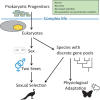Mitonuclear Ecology
- PMID: 25931514
- PMCID: PMC4833085
- DOI: 10.1093/molbev/msv104
Mitonuclear Ecology
Abstract
Eukaryotes were born of a chimeric union between two prokaryotes--the progenitors of the mitochondrial and nuclear genomes. Early in eukaryote evolution, most mitochondrial genes were lost or transferred to the nucleus, but a core set of genes that code exclusively for products associated with the electron transport system remained in the mitochondrion. The products of these mitochondrial genes work in intimate association with the products of nuclear genes to enable oxidative phosphorylation and core energy production. The need for coadaptation, the challenge of cotransmission, and the possibility of genomic conflict between mitochondrial and nuclear genes have profound consequences for the ecology and evolution of eukaryotic life. An emerging interdisciplinary field that I call "mitonuclear ecology" is reassessing core concepts in evolutionary ecology including sexual reproduction, two sexes, sexual selection, adaptation, and speciation in light of the interactions of mitochondrial and nuclear genomes.
Keywords: adaptation; coadaptation; genomic conflict; sexual reproduction; sexual selection; speciation.
© The Author 2015. Published by Oxford University Press on behalf of the Society for Molecular Biology and Evolution. All rights reserved. For permissions, please e-mail: journals.permissions@oup.com.
Figures




References
-
- Andersson M. 1994. Sexual selection. Princeton (NJ): Princeton University Press.
-
- Andersson M, Simmons LW. 2006. Sexual selection and mate choice. Trends Ecol Evol. 21:296–302. - PubMed
-
- Arnold S. 2012. The power of life—cytochrome c oxidase takes center stage in metabolic control, cell signalling and survival. Mitochondrion 12:46–56. - PubMed
Publication types
MeSH terms
LinkOut - more resources
Full Text Sources
Other Literature Sources
Miscellaneous

